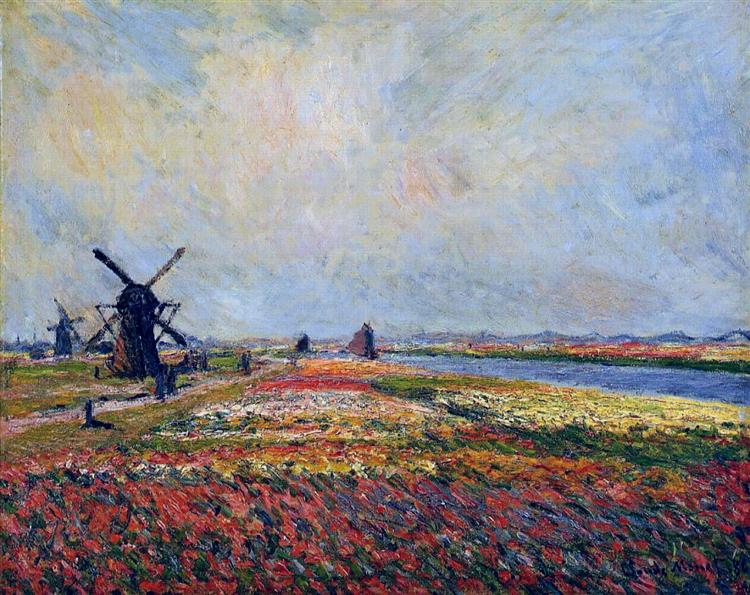Description
The work "Flowers of flowers and windmills near Leiden" (1886) by Claude Monet is a glorious expression of the artist's trip to the Netherlands, where he immerses himself in a vibrant landscape, full of color, light and the ephemeral essence of nature. Monet, one of the founders of the impressionist movement, not only captures the view, but also translates the sensory experience of a place through its loose brushstroke and its attention to the changing light.
The composition of the painting presents a delicate balance between the flowers of flowers, which dominate the lower part, and the windmills, which emerge majestic in the background. The horizontality of the work is interrupted by the verticality of the mills, which are iconic representations of the Dutch countryside. This contrast forms a subtle dialogue between nature and human intervention, evoking a sensation of coexisting harmony.
Monet uses a rich and luminous palette to emphasize the explosion of colors in the fields. Yellow, purple and green tones flow together, creating an almost daily but sublime floral effect. Monet's short and rapid brushstrokes allow the viewer to perceive not only the shape, but also the movement: the wind that caresses the flowers, the breeze that plays with the blades of the mills. This technique, characteristic of impressionism, provides almost dynamic quality to the work, attracting attention to the immediacy of the moment.
In this landscape, the absence of human figures invites the viewer to enter the environment without distractions. Monet often chose not to include characters in their landscapes, which reinforces the idea of a direct connection between the observer and nature itself. The intimacy of this scenario invites a silent contemplation, leading the viewer to experience the landscape in a very personal way.
It is interesting to observe that this work, although it dates from 1886, is in the context of a monet in transition. At this time, the artist already had a long career in the development of his distinctive style. The experience acquired in light and color adds to its constant search to capture the transience of the moment, a recurring theme in Monet's work. In this sense, "Flowers of flowers and windmills near Leiden" can be seen as a reflection of both its technical mastery and its deep spiritual connection with nature.
This painting is also a remarkable example of how Monet adopted local themes and landscapes during its trips to different regions. In Leiden, Monet was able to observe and capture the particular beauty of tulips, an emblematic flower in the Netherlands, integrated in a set that reflects the rich tradition of Dutch painting. Its attention to the light and atmospheric effects resembles the work of some masters of the seventeenth century, although Monet's approach is decidedly contemporary and personal.
Thus, "flowers and windmills near Leiden" not only stands as a sublime sample of Monet's talent, but as a milestone in the evolution of impressionism, a testament of its ability to transform direct observation into an experience Emotionally resonant. The work remains a reminder of the beauty of natural landscapes and how art can capture the ephemeral essence of life itself.
KUADROS ©, a famous paint on your wall.
Hand-made oil painting reproductions, with the quality of professional artists and the distinctive seal of KUADROS ©.
Reproduction service paintings With a guarantee of satisfaction. If you are not completely satisfied with the replica of your painting, we refund your money 100%.

